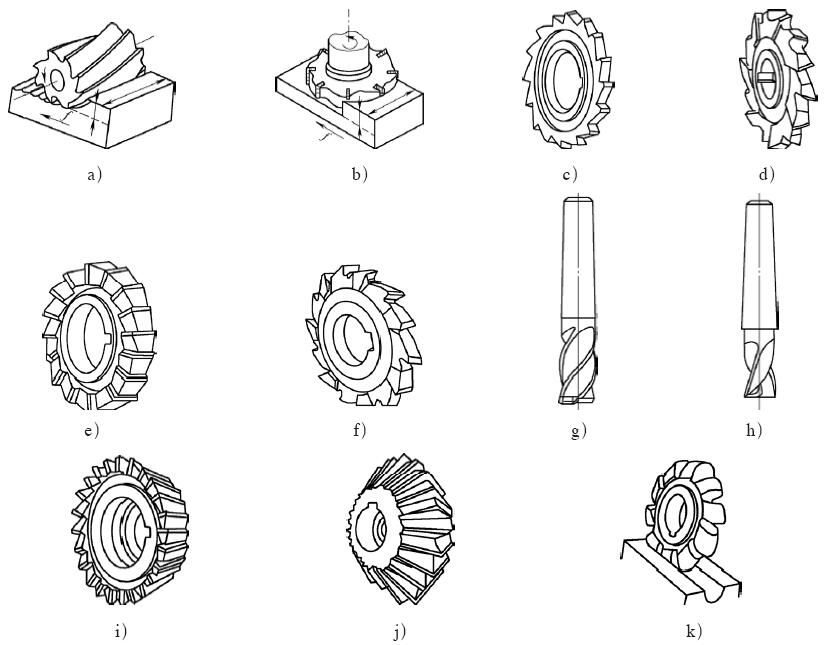A milling cutter is a rotary cutter with one or more teeth for
milling processing. When working, each cutter tooth intermittently cuts off the margin of the workpiece. Milling cutters are mainly used for milling upper planes, steps, grooves, forming surface processing and cutting off workpieces.
Several common forms of milling cutter products are shown in Figure 4-1.

Figure 4-1 Type of
milling cutter
a)Cylindrical face milling cutter
b)b) Face milling cutter
c)c) Slot milling cutter
d) Double-sided face milling cutter
e) Three-sided face milling cutter
f) Staggered tooth three-sided face milling cutter
g) End mill
h) Keyway milling cutter
i) Single angle milling cutter
j) Double angle milling cutter
k) Forming milling cutter
Classification of milling cutters
(1) Classified by function
1. Cylindrical
milling cutters are used to process planes on horizontal milling machines, and the cutter teeth are distributed on the circumference of the milling cutter. According to the tooth shape, it is divided into two types: straight tooth and helical tooth. According to the number of teeth, it is divided into sparse teeth and dense teeth. The helical tooth and sparse tooth milling cutters have fewer teeth, high tooth strength and large chip holding space, which are suitable for rough machining; while close-tooth milling cutters are suitable for fine machining.
2. Face milling cutter is used to process plane on vertical milling machine, horizontal milling machine or gantry milling machine. There are knife teeth on the end face and the circumference. Face milling cutters are also divided into coarse and fine teeth, and their structure has three types: integral type, insert type and indexable type.
3. End mills are used to process grooves and step surfaces. The cutter teeth are on the circumference and end surfaces, and generally cannot be fed along the axial direction when working. When the end mill has a passing center tooth, it can feed axially.
4. Three-sided edge milling cutter is used to process various grooves and stepped surfaces, with teeth on both sides and circumference.
5. Angle milling cutters are used for milling grooves at a certain angle. There are two types of single-angle milling cutters and double-angle milling cutters.
6. Saw blade milling cutter is used to process deep grooves and cut off the workpiece, and there are more teeth on the circumference. In order to reduce the friction during milling, there are 15'~1° secondary deflection angles on both sides of the cutter teeth.
7. Die milling cutters Die milling cutters are used to process mold cavities or punch forming surfaces. Die milling cutters are evolved from end mills. According to the shape of the working part, they can be divided into three types: conical flat head, cylindrical ball head, and conical ball head. Carbide mold milling cutters are very versatile. In addition to milling various mold cavities, they can also replace hand files and grinding wheels to clean the flash of casting, forging, and welding workpieces, and to smooth some forming surfaces. Processing etc. The milling cutter can be used on pneumatic or electric tools, and its productivity and life span are dozens of times higher than those of grinding wheels and files.
8. Gear milling cutters Gear cutting cutters that work according to the profiling method or the non-instant center envelope method are divided into disc gear milling cutters and finger gear milling cutters according to different shapes.
9. Thread milling cutter A tool for milling threads through a three-axis or more than three-axis linkage machining center.
In addition, there are keyway milling cutters, dovetail milling cutters, T-slot milling cutters and various forming milling cutters.
(2) Classified by product structure
1. Integral type: The cutter body and the cutter teeth are made into one body.
2. Integral welding tooth type The cutter teeth are made of cemented carbide or other wear-resistant tool materials and brazed on the cutter body.
3.Insert tooth type The tooth is fastened to the body of the tool by mechanical clamping. This replaceable cutter tooth can be a cutter head made of integral cutter material, or a cutter head made of welding cutter material. A milling cutter with a cutter head mounted on a cutter body for sharpening is called an internally sharpened milling cutter; a cutter head sharpened separately on a fixture is called an externally sharpened milling cutter.
(This article is selected from Chapter 4, Section 1 of "Guide to Selection of CNC Tools")

